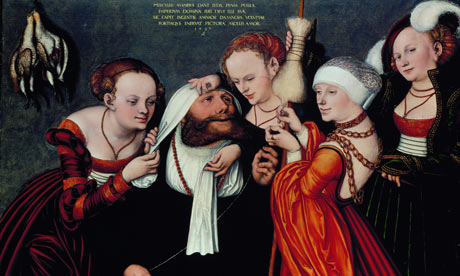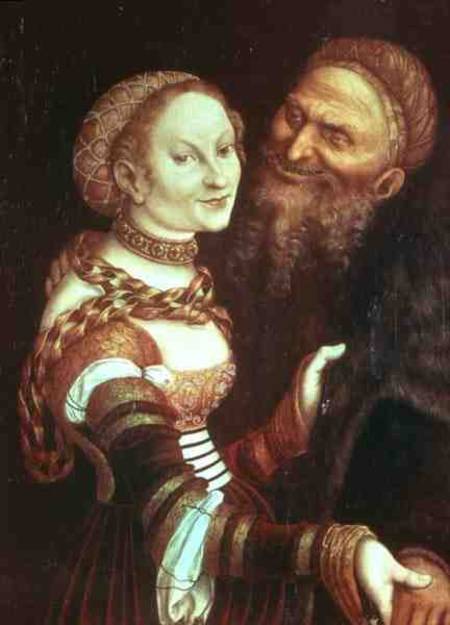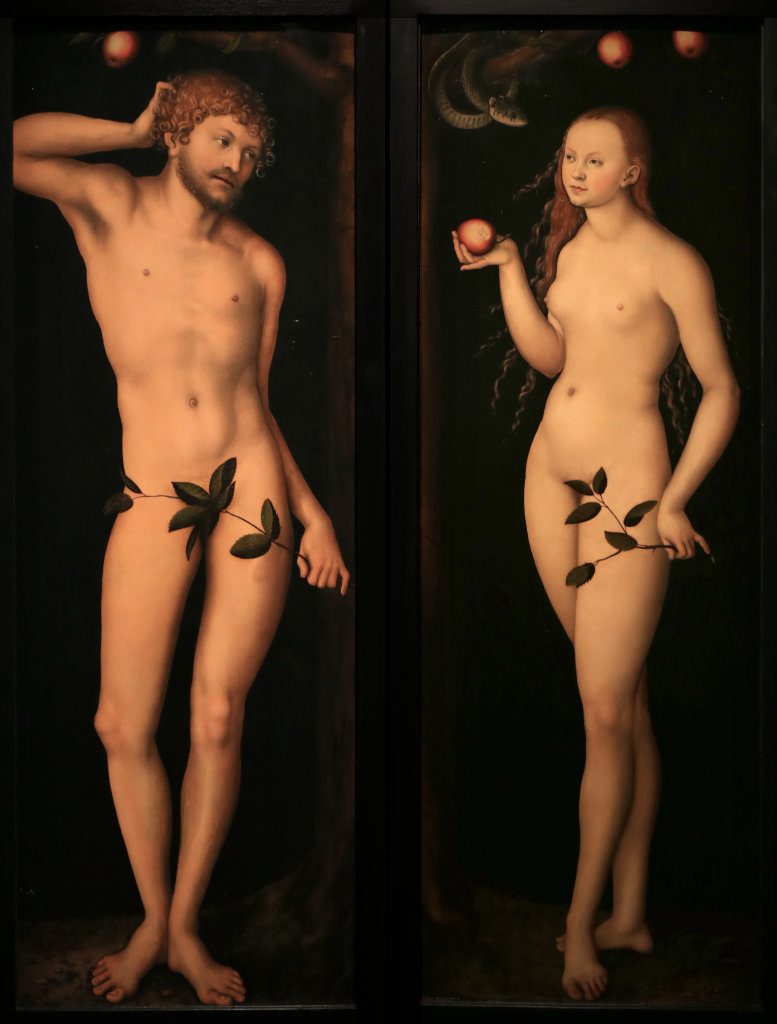Cranach and His Time
An exhibition at the Musée du Luxembourg, Paris 9 February 2011 / 23 May 2011
Lucas Cranach (circa 1472-1553) was one of the major artists of the German Renaissance. This prolific, versatile painter whose career spanned the first half of the 16th century, was still somewhat unknown to the French public, who had not had an opportunity for some time to discover the breadth of his work. The Musée du Luxembourg’s exhibition, Cranach and his time, provides a better understanding of this artist’s place in the history of art and his involvement in the society of his time, a period marked by major political and religious upheavals.

Playful ... Hercule and Omphale. Photograph: Fondation Bemberg, Toulouse
The exhibition started by showing the European dimension of Lucas Cranach’s art, which was not only influenced by the works of Dürer, whose engravings were widely disseminated, but also by Flemish and Italian artists. To highlight these influences, the exhibition compares paintings, drawings and engravings by Cranach with the works of other artists. It devotes a significant section to his travels, which were facilitated by his appointment in 1505 as official court painter to Frederick the Wise, Elector of Saxony, in Wittenberg. In addition to the artistic commissions of his patron, Cranach was entrusted with diplomatic missions that played a crucial role in his rise to prominence.
At the behest of Frederick the Wise, Cranach went to Malines in Flanders in 1508, to the court of Margaret of Austria, regent of the Netherlands, where he met many artists and humanists from different countries. It was here in this dazzling society that he perfected his artistic style. He introduced a more refined elegance into his works, and turned his attention to new themes, like his half-length images of strong, virtuous women, which were immediately successful in this aristocratic milieu.
A further section of the exhibition was devoted to his representation of the nude – a subject that occupied a central place in Cranach’s work. His highly sensual, female figures, sometimes borrowed from classical antiquity

(Venus,

Diana, etc),
sometimes from Christian culture

(Eve),
are endowed with a beauty that is at times quite disturbing. And he developed a canon of beauty that is clearly at odds with the classical ideal of the Renaissance.
These equivocal images, mixing eroticism with a moral message, often with a complex meaning, were highly acclaimed in their time, prompting the artist to reproduce them in a number of variants. His consummate business sense even pushed him to organise his studio more efficiently, in order to respond as quickly as possible to demand.
Above all, the exhibition emphasises the richness and originality of Cranach’s artistic career – a career punctuated by significant encounters with leading political and religious figures of the time - a period that was shaken by the turmoil of the Protestant Reformation. In Wittenberg he was in close contact most notably with Martin Luther who was protected by Frederick the Wise. Thanks to Cranach’s talents as a portrait painter, we have accurate representations of the leading figures of his time. A committed supporter of the Reformation within a very short time, he became very involved in helping to spread the new doctrine, using his artistic skills for visual propaganda, which was then widely circulated through engravings. Through this, he contributed to the development of a new Protestant iconography without, however, giving up his commissions from the Catholic church.
His fame as a painter, his position close to those in power, his proximity to intellectual circles, make Lucas Cranach one of the most unusual and astonishing figures in 16th century Europe.
From a review in The Guardian (images added):
Lucas Cranach, the Elder (1472-1553), was working at a key moment of the early Renaissance in northern Europe. When he started his career in Vienna in about 1500 his painting was brilliant and intense, which no doubt explains his appointment by the Elector of Saxony, Frederick the Wise, as the official painter at the court of Wittenberg. Thanks to this rare distinction, with wages to match, he became one of the town's most prosperous citizens.
Subsequently he hardly left the place, but for a few short trips, establishing a studio where his two sons and a dozen or so apprentices laboured using methods akin to an assembly line. The first part of Cranach and His Time focuses on his work as a court painter. At the time his patron, Frederick III, was a very devout man. He collected religious relics and expected Cranach to produce a steady supply of paintings featuring the Madonna and Child, the Holy Family and St Catherine, no one in those days doubting their power of intercession.
As a good humanist, Frederick also took an interest in the ancient world. The court historian, Georg Spalatin, found Trojan origins for the royal family of Saxony. In passing the Trojans must have been particularly prolific, because at the time the French also thought that the Gauls were the descendants of survivors of the Iliad. Cranach accordingly did several versions of the Judgment of Paris and Aphrodite.
But then came Martin Luther and publication in 1517 of his 95 theses, attacking in particular the indulgences sold by Rome, to pay for the rebuilding of St Peter's basilica. Luther also lived in Wittenberg, and was a protege of the elector and a friend of Cranach. The latter set to work in his service. He painted a portrait of the great reformer, illustrated some of his texts and used some of his own favourite themes to further the cause. Members of the reformed church saw his paintings of

Lucretia preparing to stab herself after being raped,
or the execution of St John the Baptist,
as symbols of resistance against oppression. Following the defeat in battle of the Protestant camp in Saxony, the ever opportunistic Cranach nevertheless did portraits of the Catholic victors.
For an audience unfamiliar with northern European painters, the exhibition also reveals the extent to which this art form is constantly in two minds, torn between Italian and Flemish influences. For a long time the former style was predominant: for instance, the

Martyrdom of St Catherine, painted in 1508,
is an exact contemporary of Michelangelo's frescoes in the Sistine chapel.
But although people in the north were drawn by Italy, where they often waged war, they also had their own identity. As early as the first century Tacitus, in his book Germania, favourably compared northerners' customs (in particular monogamy and chastity) to the depravity of his compatriots. In the context of the Reformation this was a powerful idea.
Keep this in mind when looking at the most amusing paintings in the present show, such as

Ill-Matched Lovers,
in which an old man lusts after a younger woman while she dips a hand into his purse. This is a recurrent theme. Urs Graf used it in a drawing at the same period, adding a young admirer who pockets the money.
In the
Mouth of Truth
a woman swears she has never been touched by anyone but her husband, supported by a fool who also happens to be her lover. Here Cranach puts his finger on the fear of being cuckolded that obsessed Renaissance society, 28 being the average age for men to wed, but only 15 for women.

"Saint Christopher" by Lucas Cranach the Elder. Museo Thyssen-Bornemisza, Madrid
From a review in the NY Times (images added)
Right at the beginning of the show, a self-portrait painted by the master in 1531 at age 59 gives one of the clues to Cranach the Elder’s oeuvre. With his head seen tilted back three-quarters, the artist looks at the viewer out of the corner of his eye. His lips are shut tight over clenched teeth. This is a man seized with cold rage, which he manages to keep in check — just. That anger comes across through much of Cranach’s work.
It alternates with unfathomable ambiguity conveyed through the women’s thin smiles that are even more threatening than his male sitters’ grimmest expressions.
The art historian Guido Messling, who put the show together, notes in the exhibition book that Cranach had become “one of the wealthiest burghers in Wittenberg,” where he spent much of his career after being appointed peintre-du-roy to the elector of Saxony in 1505. Clearly, the painter’s fury had nothing to do with his personal circumstances.
Life smiled on the artist, who was born in 1472 at Kronach and trained under his father, Hans Maler (“Hans the Painter”). Hugely successful from his early 30s on, Cranach the Elder was an accomplished businessman. He ran a studio that churned out scores of works to satisfy an ever-expanding demand and eventually had his son, Lucas Cranach the Younger, sharing the burden with him. Lucas Cranach Sr. was himself renowned for the speed with which he produced those pictures that were entirely from his own hand.
Cranach, who was closely involved in the political and religious affairs of the age, supported Martin Luther’s reform campaign, which became the Protestant movement. At the same time, the artist was adroit enough to continue to receive commissions from the Roman Catholic Church.
Of all the great artists who turned out to be skilled operators, Cranach the Elder was perhaps the most brilliant. Yet no remote suggestion of the happiness that this might have induced can be detected in any of the paintings that are credited to him.
Around 1510, the master painted
“Adam and Eve”
on two panels designed to be hung side by side. Adam, seen standing close to a tree half of which is visible at the edge of the composition, frowns mirthlessly. A faint suggestion of sarcasm can be detected in his expression as he points two fingers at the apple poised in his left hand while looking at Eve who appears in the second panel. She too holds an apple with one hand. The snake hanging from a branch of the tree opens its mouth with a near-human sneer at the woman, who looks at the viewer with a mixture of exultation and bitterness. Cranach dealt several times with this subject. While none of the variants is nearly as gloomy as the original version, disturbing irony emanates from most.
The German painter was the earliest Western artist who used traditional themes from the Scriptures to paint scenes in which worldly feelings, vividly conveyed, override the religious message. In a Virgin and Child done around 1515, Mary appears as a young woman breastfeeding her baby. Her dreamily pouting expression is made poignant by the inexperienced naïveté of extreme youth.
In “The Martyrdom of Saint Catherine,”
possibly dating from the years 1508-1509, the subject provided Cranach with an excuse for depicting a ferocious civil war scene. A spadassin stands behind a richly clad noblewoman who is kneeling, hands clasped in prayer, with an expression of frozen terror. The man places his hand around Catherine’s face and grabs her by the chin while prodding her in the back with a sword that he is slowly unsheathing. Nearby, a man with his back apparently broken has fallen off the enormous wooden wheel of a rack. A tempest rages in the sky. The composition dwells on human savagery and the mindsets that drive it. The spadassin’s face ranks among Cranach’s fiercest psychological studies of fury unleashed. Religion seems very far indeed.
When purporting to portray saintly characters, Cranach appears to have been unable to give up this obsession with the angry world in which he lived.
Saint Christopher (left)
carrying the infant on his shoulders as he wades across a brook is featured as a middle-aged man, grim and tired, with deep furrows coming down his nose as he raises his eyes to glance at the viewer.
Saint Elizabeth,
explicitly named in the halo around her head, could be a nun in her 40s wearily reading her breviary. The heavy features betray a bland hardness that is not exactly holy. The donor who commissioned the work, George, duke of Saxony, kneels in prayer in the foreground with glum despair on his unshaven face.
Cranach’s focus on the bitterness of life comes across most strikingly in his preparatory studies for portraits. Young or old, his unsmiling sitters stare with cold distress in their eyes.
A blue-eyed teenager in a sketch that once belonged to the great German collector Everhard Jabach, whose drawings were acquired by King Louis XIV of France, looks into emptiness, as if distraught by the bleak future awaiting him. A middle-aged man in a wide-brimmed hat with drooping reddish eye-lids appears to have been shedding tears.
Even Count Philipp von Solms-Lich, the powerful councillor of Emperor Maximilian I and later of Emperor Charles V, does not look too happy. The statesman is frowning, his lips shut tight like so many of Cranach’s sitters. He seems possessed by a feeling that recurs again and again in the painter’s pictures: contained anger.
An unidentified prince of Saxony in his late 20s or early 30s looks exhausted despite his young age. Sadness and weariness are suggested by his eyes lost in thought.
If Cranach saw men in all walks of life as troubled characters, the painter did not much like the women either.
He kept painting young ladies standing in the nude with their faces turned three-quarters, giving a thin smile full of irony as if amused at the ineptitude of the world around them. Whether seen under the features of Venus, with little Cupid portrayed as a lachrymose 4-year-old stealing honey, or of
“Charity”
with a posse of equally little boys, the women look haughty and hostile, inwardly laughing with disdain at those attracted by their charms laid bare.
With all his deep probing of feelings and attitudes, Cranach the Elder perceived the world as a theatrical scene. His brutes alternately wear shining armor and magnificent court attire. The young women with ambiguous smiles whose nudity is thinly concealed, or not, occasionally wear hats with expensive trimmings provocatively tilted. But their eroticism is a pose rather than a sexual incitement. It betrays Cranach’s bleak vision of mankind curiously translated in thoroughly unreal terms. Whether the men are seen driven by rage or the women parade in Eve’s costume, all do so with elegance in a kind of sinister aristocratic ballet.





